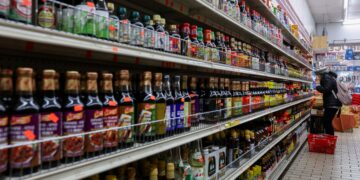May 13 (Reuters) – Tamer-than-expected inflation and a significant de-escalation of a U.S.-China trade war are easing fears of a sharp squeeze on American households and businesses in coming months, prompting Wall Street firms to pare predictions of a recession and giving the Federal Reserve room to leave interest rates where they are.
JP Morgan Chase and Barclays were among firms adjusting their forecasts on Tuesday to reflect a more benign economic trajectory after the United States and China reached a deal over the weekend to reduce the most punitive of the tariffs they had put on each other since early April.
JP Morgan economists now see the chance of a recession as less than 50%; Barclays economists no longer have recession in their forecast at all. Both had earlier expected high tariffs to hit consumers and firms hard, putting the brakes on spending and economic activity.
Financial markets also repriced after the U.S.-China agreement, slashing bets that the Fed would need to start cutting rates by July to cushion an economic downturn. Traders now see just two interest-rate cuts by year’s end, beginning in September.
A Labor Department report Tuesday showing consumer prices rose 2.3% in April, the smallest year-over-year gain in more than four years, solidified those market bets and the expectation that Fed policymakers will deliver gradual rate cuts later in the year instead of taking earlier, more aggressive action.
“There’s been a fear that tariffs are going to push inflation higher, and they may still, but today’s data at least gives investors a sense of relief that inflation is still moving in the right direction,” said Jake Dollarhide, CEO at Longbow Asset Management.
Still “uncertainty about tariff policies and implications for inflation going forward will keep them on the sidelines for now,” wrote economists at Raymond James.
The Fed last week held short-term borrowing costs in the 4.25%-4.50% range, where they have been since December.
Fed Chair Jerome Powell said at the time that he saw so far no signal in the data of a crumbling economy, and with inflation still above the Fed’s 2% target and trade policy evolving rapidly it was the right move to wait for more clarity before adjusting rates.
Underlying consumer prices excluding volatile food and energy rose at a heated 2.8% year-over-year pac, Tuesday’s data showed. Prices for some goods seen as vulnerable to tariff-driven price hikes, like apparel, cars and trucks, were flat or fell, bucking expectations even as more of U.S. President Donald Trump’s new tariffs announced in March and April took effect.
Economists continue to expect in coming months to see goods prices rise due to tariffs, which were as high as 145% on Chinese imports until the detente over the weekend took the rate down to 30% for many of those goods. Even with that reprieve, tariffs are far higher and cover a broader range of imports overall than any time in the last 80 or so years.
The Trump administration has sealed only one trade deal since announcing its barrage of tariffs on April 2.
“With little clarity on the final status quo for trade policy and Fed policymakers unlikely to preempt any growth or inflation developments, we now only anticipate two Fed rate cuts (instead of three), and believe the first rate cut will come in September (instead of July),” wrote EY Chief Economist Gregory Daco.
Reporting by Ann Saphir; Additional reporting by Caroline Valetkevitch, Editing by Louise Heavens and Andrea Ricci
Disclaimer: The views expressed in this article are those of the author and may not reflect those of Kitco Metals Inc. The author has made every effort to ensure accuracy of information provided; however, neither Kitco Metals Inc. nor the author can guarantee such accuracy. This article is strictly for informational purposes only. It is not a solicitation to make any exchange in commodities, securities or other financial instruments. Kitco Metals Inc. and the author of this article do not accept culpability for losses and/ or damages arising from the use of this publication.















